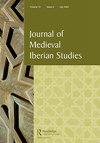塑造佩拉约的形象:中世纪早期阿斯图里亚编年史中的身份和国家建设
IF 0.4
2区 历史学
0 MEDIEVAL & RENAISSANCE STUDIES
引用次数: 0
摘要
摘要9世纪末,基督教阿斯图里亚斯王国的一系列编年史为阿斯图里亚s及其国王确立了西哥特人的身份,从而确立了在伊比利亚统治的祖先合法性。将阿斯图里亚斯王国的第一位国王佩拉约与最后几位西哥特国王联系起来,塑造他作为理想哥特人和基督徒的形象,对这一过程至关重要。本文借鉴了关于“边界”和边界制定的学术,展示了编年史家如何重新谈判哥特式身份的参数,以在合法与非法、善良的天主教徒与异端、忠诚与不忠之间强加严格的边界观念。在这样做的过程中,他们为佩拉约提供了一个分层和灵活的哥特式基督徒阿斯图里亚斯身份。本文章由计算机程序翻译,如有差异,请以英文原文为准。
Crafting the image of Pelayo: identity and state-building in early medieval Asturian chronicles
ABSTRACT In the late ninth century, a series of chronicles from the Christian kingdom of Asturias staked a claim on Visigothic identity, and thus ancestral legitimacy to rule in Iberia, for Asturias and its kings. Connecting Pelayo, the first king of the Asturian kingdom, to the last Visigothic kings and crafting his image as an ideal Goth and Christian was essential to this process. Informed by scholarship on “borderlands” and boundary-making, this article demonstrates how the chroniclers renegotiated the parameters of Gothic identity to impose the idea of a strict border between legitimate and illegitimate, good Catholic and heretic, and loyalty and disloyalty. In doing so, they provided Pelayo with a layered and flexible Gothic-Christian-Asturian identity.
求助全文
通过发布文献求助,成功后即可免费获取论文全文。
去求助
来源期刊

Journal of Medieval Iberian Studies
MEDIEVAL & RENAISSANCE STUDIES-
CiteScore
1.20
自引率
20.00%
发文量
24
 求助内容:
求助内容: 应助结果提醒方式:
应助结果提醒方式:


